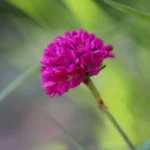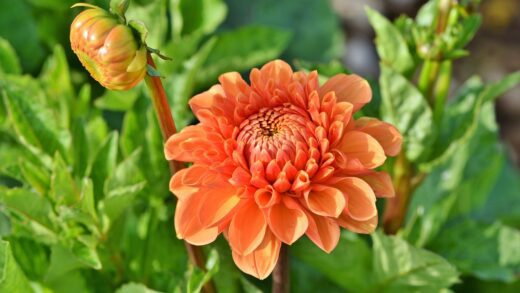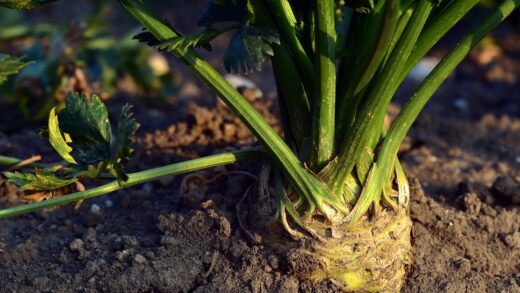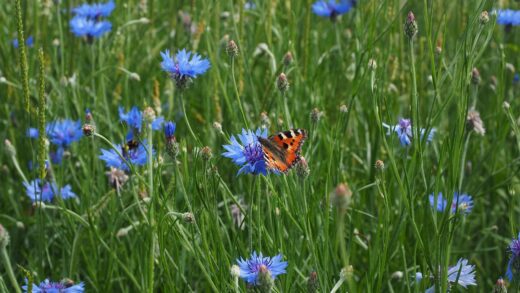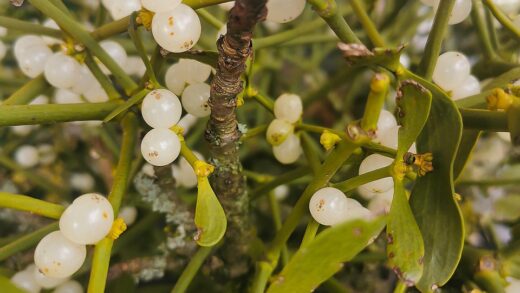Successfully establishing blue eryngo in your garden begins with a deep understanding of its unique root system and its preferences for timing and placement. This perennial is renowned for its long taproot, an adaptation that makes it incredibly drought-tolerant but also sensitive to disturbance once it has settled into its new home. Therefore, the initial planting process is a critical moment that dictates the plant’s future health and longevity. Careful planning and execution at this stage will ensure your blue eryngo thrives, developing into a structurally impressive and visually stunning specimen that requires minimal intervention in the years to come.
The ideal time to plant blue eryngo is during the cooler, moister months of spring or autumn. Planting in the spring allows the root system to establish throughout the growing season before the stresses of winter, while autumn planting gives it a head start for vigorous growth the following year. Avoid planting during the peak heat of summer, as this can place significant stress on the young plant and hinder root development. When selecting plants from a nursery, choose younger specimens in smaller pots, as they will adapt more readily to a new location and are less likely to be root-bound, which can inhibit the proper growth of the essential taproot.
Propagation offers a rewarding and cost-effective way to increase your stock of blue eryngo, with several methods available to the home gardener. While division is a common propagation technique for many perennials, it is not recommended for this species due to its deep and sensitive taproot, which is easily damaged. Instead, blue eryngo is most reliably propagated from seeds or root cuttings, methods that work in harmony with the plant’s natural growth habits. Both techniques require patience but can yield a generous number of new plants that are true to the parent.
Ultimately, both planting and propagation require a gentle hand and a respect for the plant’s dislike of root disturbance. By providing the right conditions from the very beginning—full sun, excellent drainage, and a permanent location—you set the stage for success. Whether you are introducing a single nursery-grown specimen or cultivating a new generation from seed, these initial steps are the foundation upon which a healthy and resilient blue eryngo will be built, gracing your garden with its unique architectural beauty for many seasons.
Optimal timing for planting
The timing of planting is a crucial factor that can significantly influence the successful establishment of blue eryngo. The most favorable seasons for this task are spring and early autumn, as the cooler temperatures and more consistent moisture levels reduce transplant shock and support robust root development. Spring planting, after the last frost has passed, allows the plant to utilize the entire growing season to establish its deep taproot before facing the challenges of winter dormancy. This timing is particularly advantageous in colder climates with shorter growing seasons, giving the plant the maximum amount of time to settle in.
More articles on this topic
Alternatively, planting in early autumn can be equally effective, especially in regions with mild winters. The soil is still warm from the summer sun, which encourages rapid root growth, while the cooling air temperatures reduce water loss from the foliage. An autumn-planted blue eryngo will focus its energy on establishing its root system rather than producing top growth, leading to a more vigorous and well-rooted plant come the following spring. It is essential to plant at least six to eight weeks before the ground freezes to ensure the roots have sufficient time to anchor themselves properly.
Planting during the heat of mid-summer is strongly discouraged. The combination of high temperatures and intense solar radiation places immense stress on a newly transplanted perennial, forcing it to expend energy on survival rather than on establishing a healthy root system. This can lead to stunted growth, wilting, and a much higher rate of failure. If summer planting is unavoidable, it is imperative to provide consistent moisture and perhaps some temporary shade during the hottest part of the day until the plant shows signs of new growth.
The condition of the plant itself also influences the best planting time. Small, young plants purchased in pots from a nursery are generally more adaptable and can be planted successfully in both spring and autumn. They experience less transplant shock compared to larger, more mature specimens that may already have a well-developed taproot constrained within the pot. By aligning your planting schedule with these optimal windows, you provide your blue eryngo with the best possible start in its new garden home.
Site preparation and soil amendment
Thorough site preparation is fundamental to the long-term health of the blue eryngo, as it directly addresses the plant’s two most critical requirements: full sun and excellent drainage. Before you even begin to dig, observe the chosen location throughout the day to confirm it receives a minimum of six hours of direct, unfiltered sunlight. This is non-negotiable for achieving the plant’s characteristic vibrant blue coloration and strong, upright stems. A location that is sunny, open, and has good air circulation will also help to prevent potential fungal diseases.
More articles on this topic
Once the ideal sunny spot is confirmed, the focus shifts to the soil itself, with drainage being the paramount concern. Blue eryngo is native to dry, gravelly, or sandy soils and will not tolerate “wet feet,” particularly during winter dormancy when saturated soil can lead to fatal root rot. If you have heavy clay or compacted soil, amendment is essential. You must improve its structure and porosity by incorporating materials like coarse horticultural sand, fine gravel, or perlite. These inorganic materials create air pockets in the soil, allowing excess water to drain away freely from the plant’s sensitive taproot.
When amending the soil, it is important to work the materials deep into the planting area, not just in the immediate planting hole. Aim to improve a wide area around the plant to a depth of at least 12 to 18 inches to accommodate the growing taproot. While organic matter like compost can improve the structure of clay soil, it should be used sparingly. Blue eryngo thrives in lean soil, and adding too much rich organic material can lead to lush but weak growth that is prone to flopping over, detracting from the plant’s strong architectural form.
For those with naturally sandy or gravelly soil, very little preparation may be needed beyond removing any weeds and loosening the soil. This type of soil composition is ideal for blue eryngo, closely mimicking its natural habitat. Regardless of your soil type, creating a slightly raised bed or planting on a gentle slope can also be an effective strategy to further enhance drainage, ensuring that water always moves away from the crown of the plant. This careful and considered preparation is an investment that will pay dividends in the form of a healthy, resilient, and beautiful plant.
The process for planting nursery stock
When you are ready to plant a blue eryngo that you have acquired from a nursery, the process should be handled with care to minimize stress on the plant’s sensitive root system. Start by digging a planting hole that is approximately twice as wide as the nursery pot but only as deep as the root ball. This wider hole allows you to loosen the surrounding soil, making it easier for the roots to penetrate and expand into their new environment. It is crucial not to dig the hole deeper than the pot, as this can cause the plant to settle too low, potentially leading to crown rot.
Before removing the plant from its container, water it thoroughly. This helps to hydrate the root ball and makes it easier to slide the plant out of the pot without damaging the roots. Gently tap the sides of the container and carefully ease the plant out, supporting the base of the root ball with your hand. Inspect the roots; if they are tightly circled or “pot-bound,” gently tease the outermost roots to encourage them to grow outwards into the surrounding soil. Be especially careful not to break or damage the central taproot if one has already formed significantly.
Place the plant in the center of the prepared hole, ensuring that the top of the root ball is level with or even slightly above the surrounding soil grade. This is a critical step in preventing water from collecting around the crown of the plant, which is a common cause of rot. Once you are satisfied with the positioning, begin backfilling the hole with the amended native soil, gently firming it around the root ball to eliminate any large air pockets. Avoid compacting the soil too heavily, as this can impede both drainage and root growth.
After the hole is completely backfilled, create a shallow basin or “well” of soil around the perimeter of the planting area. This helps to direct water straight to the root zone during the initial establishment period. Water the newly planted blue eryngo thoroughly, allowing the water to soak in deeply and settle the soil around the roots. For the first few weeks, monitor the soil moisture and water as needed to prevent the root ball from drying out completely, gradually weaning it off supplemental water as it becomes established.
Propagation from seeds
Propagating blue eryngo from seed is a highly effective and rewarding method for generating a large number of new plants. The seeds have a natural dormancy that needs to be broken through a process called cold stratification, which mimics the natural winter conditions they would experience in the wild. To achieve this, sow the seeds in a tray or pot filled with a well-draining seed-starting mix in late autumn or early winter. Cover the seeds lightly with mix or grit, water gently, and place the container in a cold frame, an unheated greenhouse, or a sheltered spot outdoors.
The natural cycle of winter’s cold and fluctuating temperatures will work to break the seeds’ dormancy, with germination typically occurring in the spring as the weather warms. It is important to keep the seed tray moist but not waterlogged throughout this period. Protect the tray from heavy rains that could wash away the seeds and from pests like mice or slugs. Patience is key, as germination can sometimes be slow and sporadic, but this method often yields strong, healthy seedlings that are well-acclimatized to your local conditions from the very beginning.
For those who prefer a more controlled approach, artificial cold stratification can be performed indoors. Place the seeds in a small plastic bag with a handful of moist but not wet sand or vermiculite. Seal the bag and place it in the refrigerator for a period of four to six weeks. After the cold treatment, sow the seeds in pots as you normally would and keep them in a warm, bright location, such as a sunny windowsill or under grow lights, maintaining consistent moisture until germination occurs.
Once the seedlings have emerged and developed their first true leaves, they can be carefully pricked out and transplanted into individual small pots. Use a well-draining potting mix and continue to grow them on in a bright, sheltered location. Handle the seedlings with care to avoid damaging their delicate, developing taproots. They can be planted out into their final garden positions once they have grown into sturdy young plants and all risk of frost has passed, ensuring they have the best possible start to their life in the garden.
Propagation by root cuttings
Propagating blue eryngo through root cuttings is a reliable vegetative method that produces new plants identical to the parent. This technique is particularly useful for named cultivars that may not come true from seed. The best time to take root cuttings is when the plant is dormant, typically in late winter or very early spring, before new top growth has begun. This timing ensures that the roots have a high concentration of stored energy, which will fuel the development of new shoots and leaves.
To take the cuttings, carefully excavate the soil around an established, healthy parent plant to expose some of the thicker, fleshy roots. Using a sharp, clean knife or pruning shears, select a few sections of root that are about the thickness of a pencil. Cut these into segments approximately two to three inches long. It is critically important to maintain the correct polarity of the cutting—that is, you must remember which end was closer to the plant’s crown (the proximal end) and which was the tip (the distal end). A simple way to do this is to make a flat cut on the proximal end and an angled cut on the distal end.
Prepare a pot or tray filled with a sterile, well-draining rooting medium, such as a 50/50 mix of compost and sharp sand or perlite. Insert the root cuttings vertically into the medium, ensuring the flat (proximal) cut is at the top and is positioned just level with or slightly below the surface of the mix. The angled (distal) end should be pushed down into the soil. If you are unsure of the orientation, you can also lay the cuttings horizontally on the surface and cover them with a thin layer of the rooting medium.
Water the cuttings gently and place the container in a moderately warm, bright location, but out of direct sunlight. A cold frame or a cool greenhouse is an ideal environment. Keep the medium consistently moist but not saturated to prevent the cuttings from rotting. New shoots should begin to emerge from the top of the cuttings within a few weeks to a couple of months. Once the new plants have developed a healthy set of leaves and a robust root system of their own, they can be carefully potted on or planted out into the garden.








